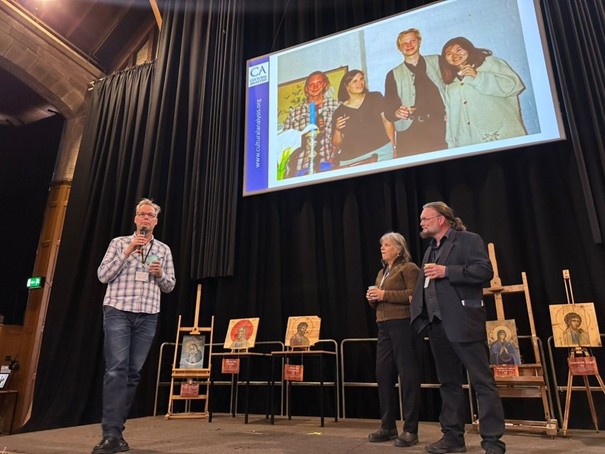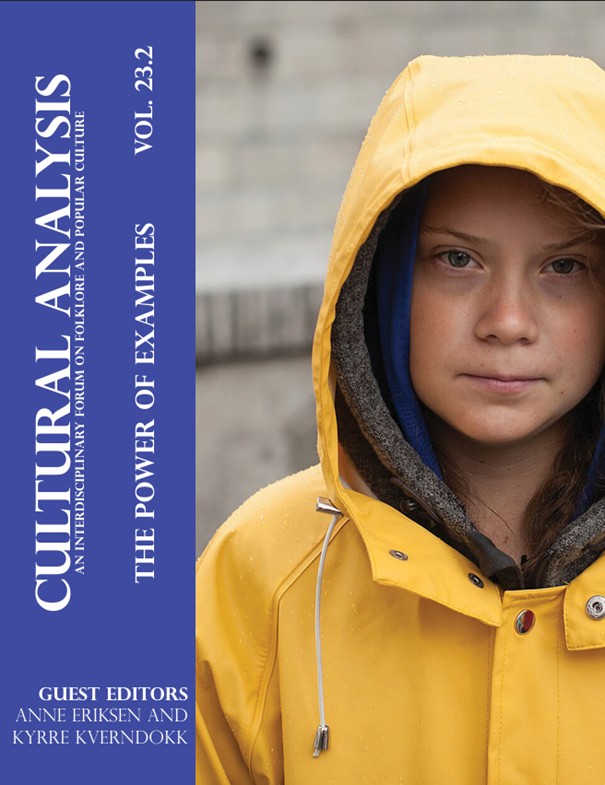
Photo: Peter Jan Margry.
SIEF journals: EE and Cultural Analysis
Ethnologia Europaea 55.2
Issue 55.2 of EE deals with Gifts broadly speaking. It features an introduction, five articles and a commentary by Roger Sansi. One of the main themes running through this SI, guest-edited by Olli Pyyhtinen and Francisco Martinez, is the concept of ‘the future’. The current geopolitical climate around the world, as well as the significance of the planet’s physical climate issues, means that the future is an ever-important topic. This SI allows us to ask and reflect upon such questions as: whose future is most often addressed and who is left out? What is the collateral damage of such decisions? Who owns which parts of stable, equitable and sustainable exchanges between human and non-human actors? As concerned scholars, how do we change our representational frameworks if we are to meaningfully give anything back to society?
Margrit Shildrick’s article on the notion of Hauntology is innovative through its conceptualisation of microchimeric gifts, offering valuable ‘biomedical anthropology’ insights. It takes the reader into a rich and complex reading of philosophical, ethnological and ethical concerns around corporeal gift-exchange relations. The introduction of the term 'microchimeric gifts' is particularly noteworthy, as it has the potential to radically challenge the social, legal and political framings of human-bodily donations. This, in turn, contributes to unsettling the Western socio-cultural imaginary of autonomous, self-contained individuality – a necessary feature in imagining a better future for more people.
Eunsil Shin’s article deals with nuclear disaster aftermaths, raising two important yet terrifying questions: How to live with the unwanted gift of radioactive soil? And, how does the materiality of this 'ecological inheritance' shape the future? It is a timely addition to current debates on toxic waste/heritage, which challenges technoscientific approaches to disaster management by providing local voices. The contribution addresses complex impacts of the Fukushima disaster, focusing on the storage of radiation-contaminated soil bags. Shin considers concepts such as “ecological inheritance” and “accursed share” to examine how the status of the bags oscillates between being a gift vs a curse in landscapes polluted with residual radioactivity. Based on fieldwork in eastern Japan, she problematises the gift, showing how contrasting notions such as gift and waste, containment and leakage, accumulation and flow, produce messy temporal distinctions.
Far from being simply material objects, the contaminated soil bags are potent signifiers of the uncertain and changeable future of Fukushima. Such findings suggest that prolonged government neglect, coupled with the unresolved issue of radioactive soil bag storage and the lack of transparency about long-term contamination risk, impacts the economy, human-nature relationships, as well as the present/future social well-being of affected communities.
Alexandra Urakova’s article on the animated film Toy Story 4 acts as a cultural text that symbolically conveys ideas about waste in post-industrial society. She contextualises her analysis within certain debates dealing with posthumanism and new materialism. The piece interrogates the identity and performance of the character Forky (a living toy made of trash) in terms of possession, dispossession, and materiality of waste. The perspective is extended by reflecting through two 19th-century novels and pointing out a related normative Enlightenment sentimental storyline of individual value, growth, and cuteness evolving out of trash (people). The comparison allows Urakova to point out the emerging potential storyline of waste’s materiality and its resistance to human (re)possession that counters the humanising, anthropomorphising, and human-centred imagination of the animation that denies waste its own material agency.
Given Urakova’s discussion of animation film, it might make sense to take a lighter look at Francisco Martinez’s curatorial thought-piece on the moribund sides of reclaiming a once abandoned Soviet Library in Estonia. Introducing the concept of the parasitical into examples for when some gifts are delayed and/or unwanted allows for occasional forms of experimental play. In such light, against the temporal background of the future, some readers might be reminded of the animated series ‘Futurama’ in which the second programme of the third series was entitled Parasites Lost (2001).1
After eating a dodgy sandwich from a service station, some worms have lodged themselves into the character Fry’s colon. These will progressively transform him into a strong and smart man who falls for his colleague Leela. Pleased with this new Fry, she uses some hacking techniques to keep the parasites within him when he tries various ways to expel them. Now the notions of hacking and resistance are drawn upon in Martinez’s piece when a forgotten Library from the Soviet era in Estonia is collaboratively reclaimed with artistic intent.
Sophie Woodward’s wardrobe ethnography examines how everyday objects, in the context of British households, pass through a necessary 'dormant' gift phase. The piece’s strong ethnographic foundation offers insightful reflections on the cultural and material aspects of keeping things at home. Woodward makes a further secondary argument concerning how the imagination places a key role in gifting: the gifter imagines a future of the recipient with the gift. Receivers, for their part, also engage in imaginative exercises – for instance, of imagining the giver’s realisation that the gift has possibly been forgotten, discarded or even given away.
Finally, the SI closes with a short commentary by Roger Sansi that acts as an epilogue to the short introduction offered by the guest editors.
1Futurama’s Parasites Lost [S3, E2] is based on the film Fantastic Voyage 1966, a story of repairing the brain of a scientist through nanotechnology (some readers might even be reminded of another comedic variation of this theme within an episode of The Mighty Boosh [also S3, E2] Journey to the Centre of the Punk.
Cultural Analysis
Cultural Analysis celebrated its 25th anniversary at SIEF2025 in Aberdeen.

Photo: Peter Jan Margry.
Three of the journal’s four founders—Valdimar Tr. Hafstein, JoAnn Conrad, and Tok Thompson (with Karen Miller unable to attend)—shared their reflections on the first years of Cultural Analysis.
Established in 2000 in the Berkeley Folklore Archives, Cultural Analysis has since published over 23 online open-access volumes. From the beginning, the journal's mission has been to make high-level folklore scholarship as widely available as possible to the international scholarly community.
Dedicated to investigating expressive and everyday culture, the journal publishes analytical research articles as well as notes, reviews and cross-disciplinary responses.
You can find the first issue from 2000 here:
https://www.ocf.berkeley.edu/~culturalanalysis/volume1/vol1_toc.html
Volume 23.2: Power of Examples
Guest editors: Anne Eriksen and Kyrre Kverndokkn
From the introduction: “The present collection of articles brings the study of examples into the fields of cultural analysis, ethnology, and folklore studies. Concentrating on the three aspects performativity, epistemology, and narrative, as well as the relations between them, the texts explore the function, power, and rationality of examples and exemplarity. They demonstrate how examples are put to work in different cultural contexts, how their authority and cultural power are established, and how examples may be challenged, changed and renegotiated. It is our hope that the articles will contribute to further development of a theory of examples and exemplarity within cultural analysis.”
Articles
Antti Lindfors
University of Helsinki, Finland
Evidential Exemplarity and the Science-Driven Self-Spirituality of the Wim Hof Method
Kyrre Kverndokk
University of Bergen, Norway
The Greta Story and the Narrative Authority of the Exemplar
Audun Kjus
Norsk Folkemuseum (The Norwegian Museum of Cultural History), Norway
Between the Crisis Ladder and the Utopia of Frugality: Negotiating Exemplarity in Current Imagined Futures
Anne Eriksen
University of Bergen, Norway
The Epistemology of Examples: Models and Numbers in the Folklife Studies of Eilert Sundt (1857)
Marit Ruge Bjærke
University of Bergen, Norway
Between Formlessness and Form: A Red King Crab on the Brink of Exemplarity
Response
Barbro Blehr
Stockholm University, Sweden
Additional Thoughts: Contextual Aspects of Examples and Exemplarity
You can find the whole issue here Cultural Analysis 2025 and here Cultural Analysis Vol. 23.2 Power of Examples (PDF)





